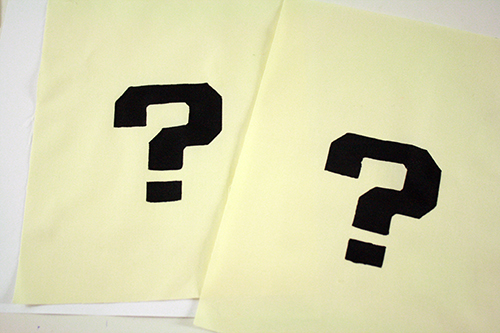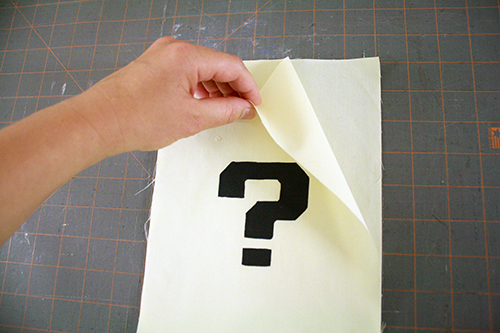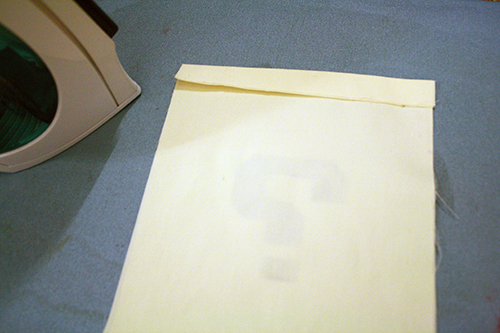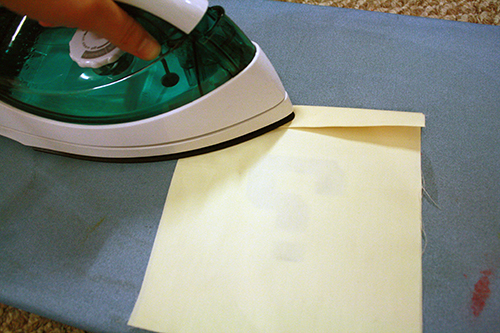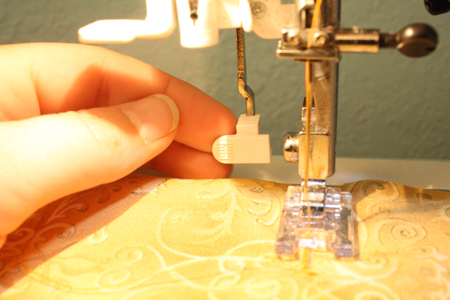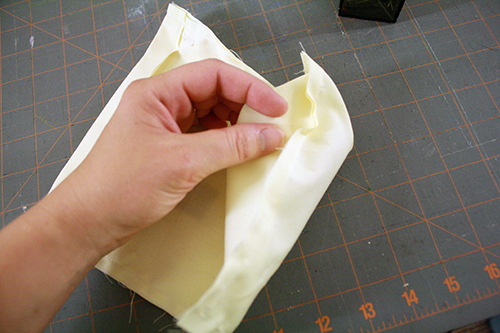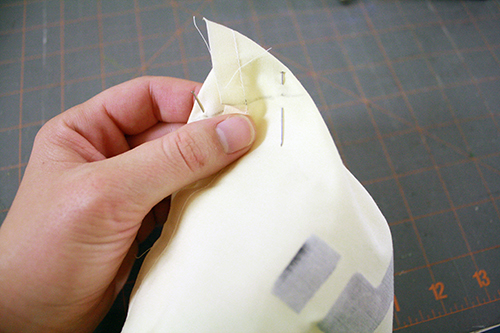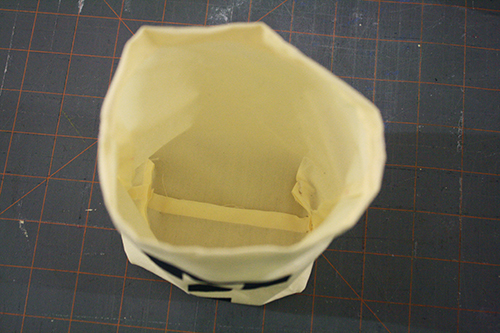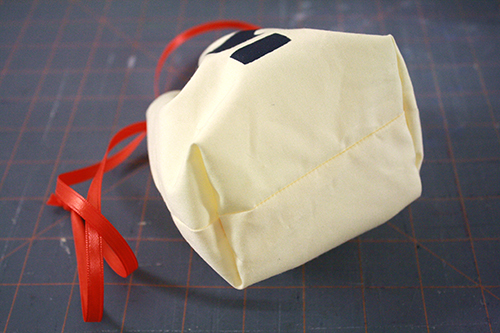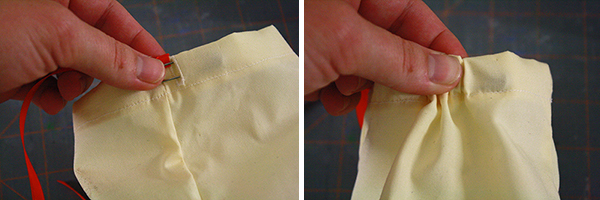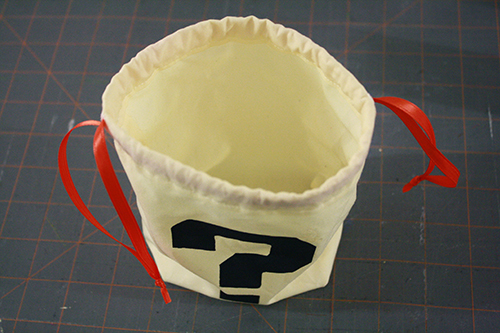Last week I promised an extra blog post this week, to make up for that one that got missed entirely a couple weeks ago. And here it is! Another handy method of bag/pouch making.
I’m a particular fan of this tutorial for a couple reasons. This project can easily incorporate last week’s lesson on making and using your own stencils, which is quite a lot of fun. This tutorial will also demonstrate a super easy, super handy way of giving a bag a flat bottom. And that same technique can be used on plushies, as well. It is, for example, how I did the flat bases of the Creepy Doll plushies back in 2010 and, more recently, the Pineapple Maki plushies. It’s a useful little technique. And did I mention it’s really easy?
And finally, it shows you the also very simple way of doing a double drawstring bag, which is easier to open and close than a single drawstring, and if you’re making a bag with an image on the front, it keeps the drawstrings from dangling down in front of your pretty picture.
Note that you could also combine techniques from my tutorial for round, lined dice bags with this one, in order to make lined flat-bottomed drawstring bags.
———————————————–
What you’ll need
materials:
- fabric (how much depends on the size of the bag you want to make, but for a small bag like I made you only need, like, an 8th of a yard) – plain or patterned cotton works well
- thread to match your fabric
- ribbon
- scissors
- cutting mat & rotary cutter OR ruler and pencil
- iron & ironing board
- sewing machine
- seam ripper OR very small pointy-ended scissors
- straight pins
- medium to large sized safety pin
———————————————–
Putting it all together
1) First cut two identical rectangles. The size is up to you – the bag will be slightly narrower side-to-side than the rectangles you cut, and about 2-3 inches shorter than the rectangles. My rectangles were 9″ x 7″ – a fairly arbitrary size that I decided looked about right for small treat bags or dice bags.
(As you can see, I’d already done a bit of decorating of my fabric rectangles.)
2) If you want to decorate your fabric, now is when you might want to use last week’s tutorial for a bit of stencilling. Do your stencilling, let it dry completely, and then return to this tutorial to finish making your bag.
3) Stack your fabric rectangles on top of each other, both with their right side facing towards you.
Heat up your iron, and take your fabric over to the ironing board. Lay the stacked rectangles face down, and fold their top edges down about 3/8 to 1/2 of an inch. Iron the fold flat.
Then fold the top edges down again and iron the second fold flat.
4) Unstack the two rectangles and lay them down face-up. Unfold those top edges. You should still be able to clearly see the ironed fold lines at the top of the fabric.
5) Using a pencil or a fabric-marking pen (the ink vanishes when you iron over it), draw a 1/2 inch long vertical line on each rectangle on the left-hand side, just below the bottom fold line. Make sure the line is 1/2 to 3/4 of an inch IN from the left-hand edge of the rectangle.
5) Now you’re going to take these rectangles over to your sewing machine and sew buttonholes right overtop of those marks you just made.
“Ack, buttonholes!” you scream. I promise you, they’re not that hard. If you’ve never made one before, you’ll want to practice a couple times on some scrap fabric, till you’re comfortable with the process. Have a look at your sewing machine’s manual (or look it up online) to find out exactly how to make buttonholes on your machine. It’s not really so tricky, and it’s a useful thing to know.
All machines are a little different, but on mine, for example, I simply have to turn my two dials to the red buttonhole setting, and my stitch width to the widest setting, as in the photo below.
An important note: on my machine and, I believe, on many sewing machines, the needle starts by going backwards when you are making a buttonhole. This means that I need to start the needle at the bottom of my pencil mark. The needle goes up, over, and back down again to make the buttonhole.
On my machine there’s a little buttonhole arm that comes down behind the needle (see the photo below). I ignore it at first, and just start the needle going at the bottom of my pencil mark. It goes back and forth doing a wide stitch for a moment, then starts going backwards, doing a narrow, close-together stitch. When it gets to the top of the pencil mark, I stop the needle, push the little buttonhole arm, and start stitching again. The needle does another wide stitch briefly, then comes back down the fabric, doing a narrow stitch a tiny ways apart from the the first line of stitching. Once it’s back at the bottom of the pencil mark, I backstitch to knot the thread, then lift the presserfoot and cut the thread and I’m done.
Remember to reset your sewing machine when the buttonholes are done, back to a normal straight stitch setting.
6) Use your seam ripper or a pair of small, sharp-ended scissors to dig into the fabric in the buttonhole’s center, cutting it and leaving an actual hole between the stitching.
7) When both buttonholes are done, stack your two rectangles one on top of the other again, but this time with their right sides facing together.
IMPORTANT: Fold the top of each rectangle down once, using only the first of the two ironed-in fold lines. You should still be able to see the back side of each buttonhole.
Pin them together along the sides and the bottom edge.
8) Now sew along the pinned edges, matching up the right edge of your presserfoot with the edge of the fabric, to create a 3/8 inch seam allowance. This should mean that you sew right past the outer side of each buttonhole.
9) Now comes the flat bottom part. Look at the bottom seam of the bag. Grasp the fabric on either side of that bottom seam, at one of the corners of the bag, where the bottom seam and side seam meet.
Pull the fabric on either side of the bottom seam flat, creating a triangle shape.
Lay this down flat, and draw a pencil line across the bottom of the triangle shape. Put a couple pins in along this line.
From the other side, it looks like the picture below. The bag’s side seam follows the line of the bag’s bottom seam on the other side of the pinned triangle shape. The fabric making up the triangle shape should sit flat, no wrinkles or bumps.
10) Now go sew straight along the pencil line you drew.
11) Cut off the triangular corner of the bag that’s poking out from the side of your line of stitches.
12) Repeat this process on the other side of the bag, making a triangle out of its other bottom corner. When you’re done, your bag should look like this:
And when you turn it right side out and look inside, like this:
And from the bottom, like this:
13) Now turn your bag right side out. You should still be able to see that second fold line that you ironed back at the beginning. Fold the top of the bag down, towards the inside, along that ironed fold line, and pin it into place.
14) Sew along the bottom of the folded-over fabric, inside the bag. You’ve now created a hollow tube along the top of the bag, for the drawstrings to go through.
15) Now you just have to add the drawstrings! Cut two lengths of ribbon. Make them approximately 4x the width of your bag. Take one piece of ribbon, and attach a largeish safety pin to one end of it.
16) Insert the safety pin with the ribbon into one of the button holes. Now scrunch the fabric up along the safety pin to pull the pin along through the tube of fabric at the top of the bag. (You’ll actually need to use both hands for this, it’s just that, in the photo below, one of mine was occupied with holding the camera.) Pull it all the way around the bag, past the other buttonhole, so it emerges once again from the other side of the buttonhole that it went into.
Knot the two ends of the ribbon together.
17) Now do the same thing with the other piece of ribbon, going into the other buttonhole. When you’re done, you can close the bag by pulling simultaneously on the drawstrings on either side of the bag.
18) And you’re done! This could make all kinds of handy storage pouches, from dice bags and jewelry bags to larger flat-bottomed totes for craft-supplies, toys, travelling, etc.
This is also a fairly quick and easy way to make a bunch of goodie bags for parties, or reuseable gift bags. I made 21 of these for my husband’s 30th birthday party last weekend. More about that birthday adventure soon!




